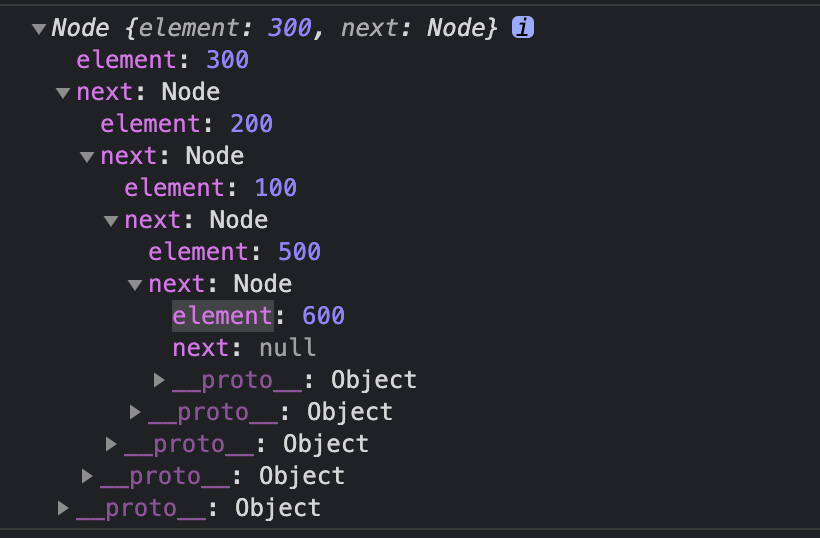实现迭代器生成函数
咱们说迭代器对象全凭迭代器生成函数帮咱们生成。在ES6中,实现一个迭代器生成函数并不是什么难事儿,因为ES6早帮咱们思考好了全套的解决方案,内置了贴心的 生成器 (Generator)供咱们应用:
// 编写一个迭代器生成函数
function *iteratorGenerator() {
yield '1号选手'
yield '2号选手'
yield '3号选手'
}
const iterator = iteratorGenerator()
iterator.next()
iterator.next()
iterator.next()丢进控制台,不负众望:
写一个生成器函数并没有什么难度,但在面试的过程中,面试官往往对生成器这种语法糖背地的实现逻辑更感兴趣。上面咱们要做的,不仅仅是写一个迭代器对象,而是用ES5去写一个可能生成迭代器对象的迭代器生成函数(解析在正文里):
// 定义生成器函数,入参是任意汇合
function iteratorGenerator(list) {
// idx记录以后拜访的索引
var idx = 0
// len记录传入汇合的长度
var len = list.length
return {
// 自定义next办法
next: function() {
// 如果索引还没有超出汇合长度,done为false
var done = idx >= len
// 如果done为false,则能够持续取值
var value = !done ? list[idx++] : undefined
// 将以后值与遍历是否结束(done)返回
return {
done: done,
value: value
}
}
}
}
var iterator = iteratorGenerator(['1号选手', '2号选手', '3号选手'])
iterator.next()
iterator.next()
iterator.next()此处为了记录每次遍历的地位,咱们实现了一个闭包,借助自在变量来做咱们的迭代过程中的“游标”。
运行一下咱们自定义的迭代器,后果合乎预期:
实现一个call
call做了什么:
- 将函数设为对象的属性
- 执行&删除这个函数
- 指定this到函数并传入给定参数执行函数
- 如果不传入参数,默认指向为 window
// 模仿 call bar.mycall(null);
//实现一个call办法:
Function.prototype.myCall = function(context) {
//此处没有思考context非object状况
context.fn = this;
let args = [];
for (let i = 1, len = arguments.length; i < len; i++) {
args.push(arguments[i]);
}
context.fn(...args);
let result = context.fn(...args);
delete context.fn;
return result;
};
Promise
// 模仿实现Promise
// Promise利用三大伎俩解决回调天堂:
// 1. 回调函数提早绑定
// 2. 返回值穿透
// 3. 谬误冒泡
// 定义三种状态
const PENDING = 'PENDING'; // 进行中
const FULFILLED = 'FULFILLED'; // 已胜利
const REJECTED = 'REJECTED'; // 已失败
class Promise {
constructor(exector) {
// 初始化状态
this.status = PENDING;
// 将胜利、失败后果放在this上,便于then、catch拜访
this.value = undefined;
this.reason = undefined;
// 胜利态回调函数队列
this.onFulfilledCallbacks = [];
// 失败态回调函数队列
this.onRejectedCallbacks = [];
const resolve = value => {
// 只有进行中状态能力更改状态
if (this.status === PENDING) {
this.status = FULFILLED;
this.value = value;
// 胜利态函数顺次执行
this.onFulfilledCallbacks.forEach(fn => fn(this.value));
}
}
const reject = reason => {
// 只有进行中状态能力更改状态
if (this.status === PENDING) {
this.status = REJECTED;
this.reason = reason;
// 失败态函数顺次执行
this.onRejectedCallbacks.forEach(fn => fn(this.reason))
}
}
try {
// 立刻执行executor
// 把外部的resolve和reject传入executor,用户可调用resolve和reject
exector(resolve, reject);
} catch(e) {
// executor执行出错,将谬误内容reject抛出去
reject(e);
}
}
then(onFulfilled, onRejected) {
onFulfilled = typeof onFulfilled === 'function' ? onFulfilled : value => value;
onRejected = typeof onRejected === 'function'? onRejected :
reason => { throw new Error(reason instanceof Error ? reason.message : reason) }
// 保留this
const self = this;
return new Promise((resolve, reject) => {
if (self.status === PENDING) {
self.onFulfilledCallbacks.push(() => {
// try捕捉谬误
try {
// 模仿微工作
setTimeout(() => {
const result = onFulfilled(self.value);
// 分两种状况:
// 1. 回调函数返回值是Promise,执行then操作
// 2. 如果不是Promise,调用新Promise的resolve函数
result instanceof Promise ? result.then(resolve, reject) : resolve(result);
})
} catch(e) {
reject(e);
}
});
self.onRejectedCallbacks.push(() => {
// 以下同理
try {
setTimeout(() => {
const result = onRejected(self.reason);
// 不同点:此时是reject
result instanceof Promise ? result.then(resolve, reject) : resolve(result);
})
} catch(e) {
reject(e);
}
})
} else if (self.status === FULFILLED) {
try {
setTimeout(() => {
const result = onFulfilled(self.value);
result instanceof Promise ? result.then(resolve, reject) : resolve(result);
});
} catch(e) {
reject(e);
}
} else if (self.status === REJECTED) {
try {
setTimeout(() => {
const result = onRejected(self.reason);
result instanceof Promise ? result.then(resolve, reject) : resolve(result);
})
} catch(e) {
reject(e);
}
}
});
}
catch(onRejected) {
return this.then(null, onRejected);
}
static resolve(value) {
if (value instanceof Promise) {
// 如果是Promise实例,间接返回
return value;
} else {
// 如果不是Promise实例,返回一个新的Promise对象,状态为FULFILLED
return new Promise((resolve, reject) => resolve(value));
}
}
static reject(reason) {
return new Promise((resolve, reject) => {
reject(reason);
})
}
static all(promiseArr) {
const len = promiseArr.length;
const values = new Array(len);
// 记录曾经胜利执行的promise个数
let count = 0;
return new Promise((resolve, reject) => {
for (let i = 0; i < len; i++) {
// Promise.resolve()解决,确保每一个都是promise实例
Promise.resolve(promiseArr[i]).then(
val => {
values[i] = val;
count++;
// 如果全副执行完,返回promise的状态就能够扭转了
if (count === len) resolve(values);
},
err => reject(err),
);
}
})
}
static race(promiseArr) {
return new Promise((resolve, reject) => {
promiseArr.forEach(p => {
Promise.resolve(p).then(
val => resolve(val),
err => reject(err),
)
})
})
}
}
查找文章中呈现频率最高的单词
function findMostWord(article) {
// 合法性判断
if (!article) return;
// 参数解决
article = article.trim().toLowerCase();
let wordList = article.match(/[a-z]+/g),
visited = [],
maxNum = 0,
maxWord = "";
article = " " + wordList.join(" ") + " ";
// 遍历判断单词呈现次数
wordList.forEach(function(item) {
if (visited.indexOf(item) < 0) {
// 退出 visited
visited.push(item);
let word = new RegExp(" " + item + " ", "g"),
num = article.match(word).length;
if (num > maxNum) {
maxNum = num;
maxWord = item;
}
}
});
return maxWord + " " + maxNum;
}
实现apply办法
apply原理与call很类似,不多赘述
// 模仿 apply
Function.prototype.myapply = function(context, arr) {
var context = Object(context) || window;
context.fn = this;
var result;
if (!arr) {
result = context.fn();
} else {
var args = [];
for (var i = 0, len = arr.length; i < len; i++) {
args.push("arr[" + i + "]");
}
result = eval("context.fn(" + args + ")");
}
delete context.fn;
return result;
};
手写 Object.create
思路:将传入的对象作为原型
function create(obj) {
function F() {}
F.prototype = obj
return new F()
}
参考 前端进阶面试题具体解答
手写 bind 函数
bind 函数的实现步骤:
- 判断调用对象是否为函数,即便咱们是定义在函数的原型上的,然而可能呈现应用 call 等形式调用的状况。
- 保留以后函数的援用,获取其余传入参数值。
- 创立一个函数返回
- 函数外部应用 apply 来绑定函数调用,须要判断函数作为构造函数的状况,这个时候须要传入以后函数的 this 给 apply 调用,其余状况都传入指定的上下文对象。
// bind 函数实现
Function.prototype.myBind = function(context) {
// 判断调用对象是否为函数
if (typeof this !== "function") {
throw new TypeError("Error");
}
// 获取参数
var args = [...arguments].slice(1),
fn = this;
return function Fn() {
// 依据调用形式,传入不同绑定值
return fn.apply(
this instanceof Fn ? this : context,
args.concat(...arguments)
);
};
};
深拷贝
递归的残缺版本(思考到了Symbol属性):
const cloneDeep1 = (target, hash = new WeakMap()) => {
// 对于传入参数解决
if (typeof target !== 'object' || target === null) {
return target;
}
// 哈希表中存在间接返回
if (hash.has(target)) return hash.get(target);
const cloneTarget = Array.isArray(target) ? [] : {};
hash.set(target, cloneTarget);
// 针对Symbol属性
const symKeys = Object.getOwnPropertySymbols(target);
if (symKeys.length) {
symKeys.forEach(symKey => {
if (typeof target[symKey] === 'object' && target[symKey] !== null) {
cloneTarget[symKey] = cloneDeep1(target[symKey]);
} else {
cloneTarget[symKey] = target[symKey];
}
})
}
for (const i in target) {
if (Object.prototype.hasOwnProperty.call(target, i)) {
cloneTarget[i] =
typeof target[i] === 'object' && target[i] !== null
? cloneDeep1(target[i], hash)
: target[i];
}
}
return cloneTarget;
}
字符串解析问题
var a = {
b: 123,
c: '456',
e: '789',
}
var str=`a{a.b}aa{a.c}aa {a.d}aaaa`;
// => 'a123aa456aa {a.d}aaaa'
实现函数使得将str字符串中的{}内的变量替换,如果属性不存在放弃原样(比方{a.d})
相似于模版字符串,但有一点出入,实际上原理大差不差
const fn1 = (str, obj) => {
let res = '';
// 标记位,标记后面是否有{
let flag = false;
let start;
for (let i = 0; i < str.length; i++) {
if (str[i] === '{') {
flag = true;
start = i + 1;
continue;
}
if (!flag) res += str[i];
else {
if (str[i] === '}') {
flag = false;
res += match(str.slice(start, i), obj);
}
}
}
return res;
}
// 对象匹配操作
const match = (str, obj) => {
const keys = str.split('.').slice(1);
let index = 0;
let o = obj;
while (index < keys.length) {
const key = keys[index];
if (!o[key]) {
return `{${str}}`;
} else {
o = o[key];
}
index++;
}
return o;
}
解析 URL Params 为对象
let url = 'http://www.domain.com/?user=anonymous&id=123&id=456&city=%E5%8C%97%E4%BA%AC&enabled';
parseParam(url)
/* 后果{ user: 'anonymous', id: [ 123, 456 ], // 反复呈现的 key 要组装成数组,能被转成数字的就转成数字类型 city: '北京', // 中文需解码 enabled: true, // 未指定值得 key 约定为 true}*/
function parseParam(url) {
const paramsStr = /.+\?(.+)$/.exec(url)[1]; // 将 ? 前面的字符串取出来
const paramsArr = paramsStr.split('&'); // 将字符串以 & 宰割后存到数组中
let paramsObj = {};
// 将 params 存到对象中
paramsArr.forEach(param => {
if (/=/.test(param)) { // 解决有 value 的参数
let [key, val] = param.split('='); // 宰割 key 和 value
val = decodeURIComponent(val); // 解码
val = /^\d+$/.test(val) ? parseFloat(val) : val; // 判断是否转为数字
if (paramsObj.hasOwnProperty(key)) { // 如果对象有 key,则增加一个值
paramsObj[key] = [].concat(paramsObj[key], val);
} else { // 如果对象没有这个 key,创立 key 并设置值
paramsObj[key] = val;
}
} else { // 解决没有 value 的参数
paramsObj[param] = true;
}
})
return paramsObj;
}
Array.prototype.map()
Array.prototype.map = function(callback, thisArg) {
if (this == undefined) {
throw new TypeError('this is null or not defined');
}
if (typeof callback !== 'function') {
throw new TypeError(callback + ' is not a function');
}
const res = [];
// 同理
const O = Object(this);
const len = O.length >>> 0;
for (let i = 0; i < len; i++) {
if (i in O) {
// 调用回调函数并传入新数组
res[i] = callback.call(thisArg, O[i], i, this);
}
}
return res;
}
递归反转链表
// node节点
class Node {
constructor(element,next) {
this.element = element
this.next = next
}
}
class LinkedList {
constructor() {
this.head = null // 默认应该指向第一个节点
this.size = 0 // 通过这个长度能够遍历这个链表
}
// 减少O(n)
add(index,element) {
if(arguments.length === 1) {
// 向开端增加
element = index // 以后元素等于传递的第一项
index = this.size // 索引指向最初一个元素
}
if(index < 0 || index > this.size) {
throw new Error('增加的索引不失常')
}
if(index === 0) {
// 间接找到头部 把头部改掉 性能更好
let head = this.head
this.head = new Node(element,head)
} else {
// 获取以后头指针
let current = this.head
// 不停遍历 直到找到最初一项 增加的索引是1就找到第0个的next赋值
for (let i = 0; i < index-1; i++) { // 找到它的前一个
current = current.next
}
// 让创立的元素指向上一个元素的下一个
// 看图了解next层级 
current.next = new Node(element,current.next) // 让以后元素指向下一个元素的next
}
this.size++;
}
// 删除O(n)
remove(index) {
if(index < 0 || index >= this.size) {
throw new Error('删除的索引不失常')
}
this.size--
if(index === 0) {
let head = this.head
this.head = this.head.next // 挪动指针地位
return head // 返回删除的元素
}else {
let current = this.head
for (let i = 0; i < index-1; i++) { // index-1找到它的前一个
current = current.next
}
let returnVal = current.next // 返回删除的元素
// 找到待删除的指针的上一个 current.next.next
// 如删除200, 100=>200=>300 找到200的上一个100的next的next为300,把300赋值给100的next即可
current.next = current.next.next
return returnVal
}
}
// 查找O(n)
get(index) {
if(index < 0 || index >= this.size) {
throw new Error('查找的索引不失常')
}
let current = this.head
for (let i = 0; i < index; i++) {
current = current.next
}
return current
}
reverse() {
const reverse = head=>{
if(head == null || head.next == null) {
return head
}
let newHead = reverse(head.next)
// 从这个链表的最初一个开始反转,让以后下一个元素的next指向本人,本人指向null
// 
// 刚开始反转的是最初两个
head.next.next = head
head.next = null
return newHead
}
return reverse(this.head)
}
}
let ll = new LinkedList()
ll.add(1)
ll.add(2)
ll.add(3)
ll.add(4)
// console.dir(ll,{depth: 1000})
console.log(ll.reverse())实现数组的map办法
Array.prototype._map = function(fn) {
if (typeof fn !== "function") {
throw Error('参数必须是一个函数');
}
const res = [];
for (let i = 0, len = this.length; i < len; i++) {
res.push(fn(this[i]));
}
return res;
}
实现一个 sleep 函数,比方 sleep(1000) 意味着期待1000毫秒
// 应用 promise来实现 sleep
const sleep = (time) => {
return new Promise(resolve => setTimeout(resolve, time))
}
sleep(1000).then(() => {
// 这里写你的骚操作
})判断是否是电话号码
function isPhone(tel) {
var regx = /^1[34578]\d{9}$/;
return regx.test(tel);
}图片懒加载
// <img src="default.png" data-src="https://xxxx/real.png">
function isVisible(el) {
const position = el.getBoundingClientRect()
const windowHeight = document.documentElement.clientHeight
// 顶部边缘可见
const topVisible = position.top > 0 && position.top < windowHeight;
// 底部边缘可见
const bottomVisible = position.bottom < windowHeight && position.bottom > 0;
return topVisible || bottomVisible;
}
function imageLazyLoad() {
const images = document.querySelectorAll('img')
for (let img of images) {
const realSrc = img.dataset.src
if (!realSrc) continue
if (isVisible(img)) {
img.src = realSrc
img.dataset.src = ''
}
}
}
// 测试
window.addEventListener('load', imageLazyLoad)
window.addEventListener('scroll', imageLazyLoad)
// or
window.addEventListener('scroll', throttle(imageLazyLoad, 1000))模仿Object.create
Object.create()办法创立一个新对象,应用现有的对象来提供新创建的对象的__proto__。
// 模仿 Object.create
function create(proto) {
function F() {}
F.prototype = proto;
return new F();
}
Promise并行限度
就是实现有并行限度的Promise调度器问题
class Scheduler {
constructor() {
this.queue = [];
this.maxCount = 2;
this.runCounts = 0;
}
add(promiseCreator) {
this.queue.push(promiseCreator);
}
taskStart() {
for (let i = 0; i < this.maxCount; i++) {
this.request();
}
}
request() {
if (!this.queue || !this.queue.length || this.runCounts >= this.maxCount) {
return;
}
this.runCounts++;
this.queue.shift()().then(() => {
this.runCounts--;
this.request();
});
}
}
const timeout = time => new Promise(resolve => {
setTimeout(resolve, time);
})
const scheduler = new Scheduler();
const addTask = (time,order) => {
scheduler.add(() => timeout(time).then(()=>console.log(order)))
}
addTask(1000, '1');
addTask(500, '2');
addTask(300, '3');
addTask(400, '4');
scheduler.taskStart()
// 2
// 3
// 1
// 4
实现防抖函数(debounce)
防抖函数原理:在事件被触发n秒后再执行回调,如果在这n秒内又被触发,则从新计时。
那么与节流函数的区别间接看这个动画实现即可。
手写简化版:
// 防抖函数
const debounce = (fn, delay) => {
let timer = null;
return (...args) => {
clearTimeout(timer);
timer = setTimeout(() => {
fn.apply(this, args);
}, delay);
};
};
实用场景:
- 按钮提交场景:避免屡次提交按钮,只执行最初提交的一次
- 服务端验证场景:表单验证须要服务端配合,只执行一段间断的输出事件的最初一次,还有搜寻联想词性能相似
生存环境请用lodash.debounce
Object.is
Object.is解决的次要是这两个问题:
+0 === -0 // true
NaN === NaN // false
const is= (x, y) => {
if (x === y) {
// +0和-0应该不相等
return x !== 0 || y !== 0 || 1/x === 1/y;
} else {
return x !== x && y !== y;
}
}
发表回复